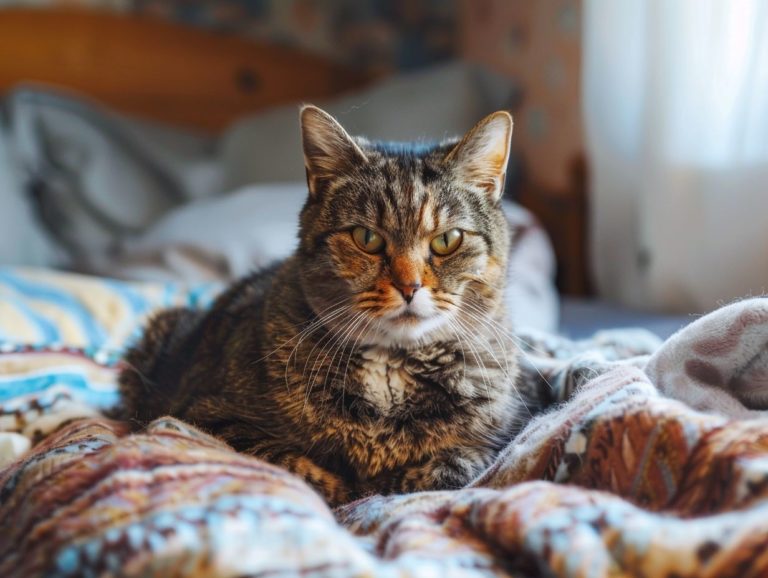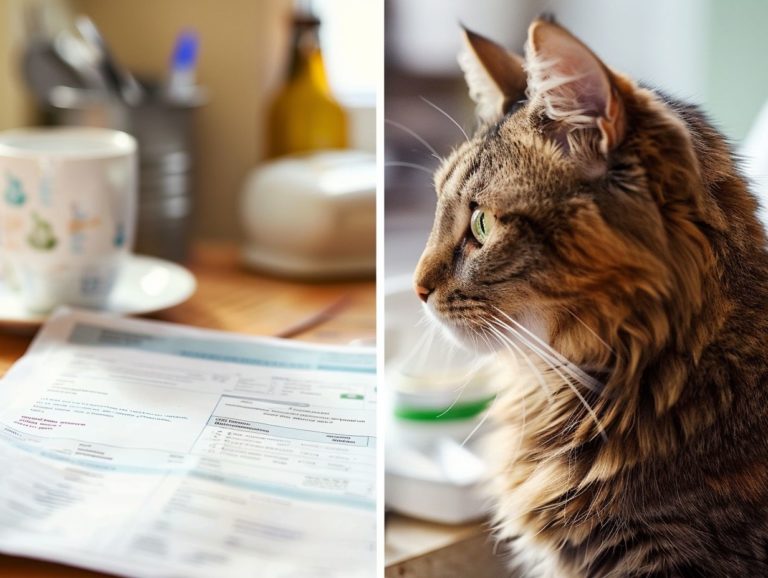Navigating The Claims Process For Senior Cat Insurance
As our cats age, it becomes increasingly crucial to prioritize their care and protection. Senior cat insurance offers peace of mind and financial support for unforeseen health issues in elderly felines. This guide discusses what senior cat insurance entails, its advantages, selecting a provider, the claims procedure, common concerns, and strategies for optimizing the benefits.
Key Takeaways:
Understanding Senior Cat Insurance
Senior Cat Insurance applies pet insurance policies to feline healthcare for elderly animals. Pet owners must understand claiming procedures, reimbursement policies, and the types of care covered to ensure proper medical care for their senior cats. Insurance policies can help alleviate veterinary costs for pet owners by covering medical treatments, surgeries, and medications for senior cats.
Claiming insurance requires documentation such as veterinary invoices, medical records, and a completed claim form, which pet owners typically submit online, via email, or by mail to the insurance company. Upon receipt, the claim will be reviewed, and if approved, reimbursement will be issued based on the policy’s coverage terms and limits.
What is Senior Cat Insurance?
Senior Cat Insurance is specifically designed to meet the unique medical needs of older cats, providing financial protection and peace of mind to pet owners. As cats age, they may require more frequent vet visits for check-ups, treatments, and urgent care services. Pet owners who have comprehensive insurance coverage can address these medical needs without worrying about the financial impact.
By purchasing Senior Cat Insurance, pet owners can ensure that their feline companions receive necessary medical attention when needed. The cost savings provided by insurance can be significant over time, making it a valuable investment in the overall health and well-being of aging cats. Senior Cat Insurance serves as a safety net for pet owners and their senior feline companions.
Why Insure Your Senior Cat?
Having pet insurance for senior cats is essential for protecting their health and quality of life as they age. A dependable pet insurance provider for older cats offers comprehensive coverage, efficient claim processes, and tailored policies to meet the specific needs of senior felines.
Understanding the nuances of pet insurance policies is crucial to ensuring optimal care for your senior cat without financial strain. Opting for a reputable pet insurance provider ensures that you have the financial support needed for unforeseen veterinary expenses. Learn how to advocate for your senior cat during an insurance claim.
Pet insurance functions similarly to human health insurance, where policies are purchased to cover a portion of necessary medical costs for the insured pet in exchange for a premium. Securing pet insurance for your senior cat is a proactive measure to cover the expenses of costly treatments and guarantee they receive the necessary care to uphold their health and well-being.
Benefits of Senior Cat Insurance
Senior Cat Insurance offers various benefits, including reimbursement for medical expenses, protection against policy exclusions, and financial assurance to afford unexpected vet visits. This type of insurance provides annual limits, deductible options, and coverage for pre-existing conditions in a comprehensive healthcare package.
Annual Limits: These ensure that owners do not have to bear excessive costs for costly medical treatments, as the annual limit protects them from such expenses. The annual limit represents the maximum amount a policy will pay out in a single policy year, typically set at $2,500, $5,000, $10,000, or unlimited, with unlimited coverage offering the best comprehensive protection for senior cats.
Deductibles: This refers to the amount of money the policyholder must pay out of pocket before the insurance company begins to cover costs. Most pet insurance companies offer deductibles ranging from $100 to $1,000, with some reaching as high as $2,500. Deductibles can be applied on an annual or per-incident basis.
Pre-existing Conditions: These are illnesses, injuries, or conditions that a pet had before the insurance coverage started. Senior cat insurance may cover pre-existing conditions after a waiting period, which can vary from a few weeks to several months.
Choosing the Right Insurance Provider
Choosing the right insurance provider for your senior cat is crucial to ensure reliable coverage that offers support when needed. Pet owners consider factors such as customer reviews, customer satisfaction, reputation, and the performance of pet insurance companies in fulfilling their commitments to policyholders when selecting a pet insurance provider.
Customer reviews provide valuable insights into the satisfaction levels and ease of claims processing with different insurance companies. A reputable pet insurance provider has a proven track record of settling claims promptly and providing excellent customer service.
The reputation of a company within the pet owner community is a key indicator of how well they handle claims for senior cats and other pets. Therefore, opting for a well-established and reputable insurance company is vital for the peace of mind of senior cats and ensuring prompt treatment for any health issues that may arise.
Factors to Consider
When choosing a senior cat insurance policy, important factors to consider include reimbursement levels, coverage options, and the likelihood of claim approval. Understanding pet insurance claims and potential outcomes enables pet owners to make informed decisions about their senior cat’s health insurance.
Reimbursement levels in senior cat insurance policies can be either a fixed amount per condition or a percentage of the actual vet bill. Pet owners should review the coverage details to ensure they align with their cat’s specific needs, such as coverage for chronic or pre-existing conditions.
Pet owners should also assess the likelihood of their insurance claims being approved, which may involve meeting requirements like promptly submitting medical records and understanding any coverage waiting periods. Being informed about these factors enables pet owners to choose the most suitable senior cat insurance policy for their individual needs and those of their pet.
The Claims Process
The claims process for pet insurance is a formal procedure in which pet owners must submit a claim form along with necessary documentation. This process enables policyholders to receive reimbursement and safeguards them against the risk of claim denials that may be imposed by certain pet insurance providers for claims that are not pre-approved or lack supporting evidence.
Pet owners submit claim forms with the required documents to their pet insurance provider. Upon receipt, the insurance company assesses the claim in accordance with the policy coverage. Providing accurate information and comprehensive details are essential aspects of a successful claim, and submitting the claim form promptly can expedite the reimbursement process. In some instances, the insurance company may request additional information or clarification. Therefore, it is crucial for pet owners to be responsive and maintain detailed records of veterinary visits and treatments.
Step-by-Step Guide to Filing a Claim
Successfully claiming reimbursement for your senior cat’s veterinary expenses involves navigating through key pet insurance concepts and following insurance claims steps. Pet owners who have a good understanding of pet insurance fundamentals and the claims process are more likely to secure timely reimbursement for their senior cat’s medical costs.
To make a claim for your senior cat’s insurance coverage, you should follow these essential steps:
- Review your policy details to understand what expenses are covered.
- Identify eligible costs and gather necessary documentation such as vet invoices, medical records, and receipts.
- Inform your pet insurance provider of your intention to make a claim.
- Submit the required documents and a claim form from your insurance provider, ensuring all information is accurate and complete to prevent processing delays.
- Follow up with your insurer to monitor the status of the claim and promptly address any additional requirements that may arise.
Common Issues and How to Handle Them
Pet owners who utilize senior cat insurance may encounter challenges such as claim denials, delayed reimbursements, or reaching their annual limits. Here are some tips to help pet owners navigate these issues, as well as manage vet visits and understand the various types of coverage available with pet insurance.
Claim Denials:
If a claim is denied, pet owners should carefully review their policy to understand the reason for the denial. They can then contact their insurance provider for clarification and provide any necessary documentation for reconsideration. If the claim remains unapproved, they have the option to file a complaint with the state insurance department.
Delayed Reimbursements:
To expedite reimbursements, pet owners should keep detailed records of vet visits and promptly submit them to the insurance provider. Most pet insurance companies offer online claim submission options, which can accelerate the reimbursement process. Reimbursements are typically disbursed through direct deposit or by check.
Annual Limits:
Pet insurance policies may have two types of annual limits – annual per-incident and annual benefit limits. The annual per-incident limit specifies the maximum amount the insurance provider will pay for a single illness or injury within a policy year. The annual benefit limit indicates the maximum amount the provider will pay for all covered illnesses and injuries in a policy year. Additionally, some insurance providers may impose lifetime benefit limits and maximum payout amounts for specific treatments like acupuncture or physical therapy. Pet owners should carefully review their policy to maximize reimbursement opportunities, consider multi-pet discounts, wellness plans, or pre-approval options to optimize the financial protection offered by pet insurance.
Managing Vet Visits:
Most insurance companies require pet owners to pay for vet services upfront and then submit a claim for reimbursement. Some insurers collaborate with vets to facilitate direct payments, streamlining the process for pet owners.
Understanding Coverage Types:
Pet owners may have accident-only or comprehensive insurance coverage. Accident-only insurance covers expenses arising from accidents but excludes coverage for illnesses or preventive care. Comprehensive insurance, on the other hand, includes coverage for accidents, illnesses, and may encompass preventive care like vaccines or dental check-ups. With comprehensive insurance, pet owners typically need to meet a deductible before the insurance provider starts covering their pet. Subsequently, they are responsible for a co-insurance payment, usually around 20% of the total vet bill. Some insurers offer a direct payment service through a mobile app, enabling automatic payment to the vet by the provider, while pet owners pay their co-insurance amount directly to the vet, ensuring prompt payment.
Dealing with Denials and Delays
Dealing with claim denials and delays from pet insurance companies involves understanding policy exclusions, reimbursement procedures, and specific coverage details. By reviewing insurance policy products and clarifying claim issues, one can effectively address denials and delays in the claims process.
To tackle claim denials and delays in senior cat insurance, it is beneficial to carefully examine the policy exclusions section of the insurance plan. Understanding which conditions and treatments are not covered can help mitigate conflicts with the insurance provider. Similarly, comprehending the reimbursement protocols is crucial. Familiarizing oneself with the claim submission requirements, necessary documentation, and reimbursement timelines can expedite the process and minimize delays.
Tips for Navigating the Claims Process
Here are strategic tips and insights for pet parents to streamline the process of filing and managing claims for a senior cat insurance policy. Understanding the policy coverage, the specifics of the insurance plan, and taking preventive measures are ways for pet owners to enhance the management of their senior cat’s healthcare claims.
- Keep documentation on hand: Collect and retain all necessary paperwork for your claim, including receipts, vet bills, and medical records.
- Understand the insurance policy: Familiarize yourself with the terms and conditions of the pet insurance policy to grasp what is covered and what may require prior authorization.
- Opt for a higher policy limit: Choosing a higher coverage limit can reduce the unexpected out-of-pocket expenses in case of a medical emergency.
- Stay in touch with your insurance provider: Maintain communication and promptly file claims with the insurance provider. This will expedite the reimbursement process and ensure your senior cat receives the necessary care.
Maximizing Your Coverage and Minimizing Hassle
To maximize benefits and minimize issues in senior cat insurance coverage, it is essential to manage vet bills cost-effectively, process claims quickly, and select the appropriate pet insurance plan that aligns with the medical needs of senior cats.
Taking an active role in the claims process enables pet owners to optimize their insurance coverage. Maintaining detailed records of all veterinary payments is a key way to enhance insurance coverage for senior cats, enabling pet owners to easily track and validate incurred costs for prompt reimbursement.
Understanding the specific coverage details of their pet insurance policy enables pet owners to make informed decisions when seeking veterinary services. Researching different insurance companies and comparing their plans helps ensure comprehensive coverage at competitive prices.
By following these steps, pet owners can approach senior cat insurance with greater confidence and achieve success in navigating its complexities.
Frequently Asked Questions
What is senior cat insurance and why is it important to have?
Senior cat insurance is a type of pet insurance that is specifically designed for older cats. As cats age, they become more prone to health issues and may require more frequent visits to the vet. Having senior cat insurance can help cover the costs of these visits and provide peace of mind for pet owners.
How do I know if my cat qualifies for senior cat insurance?
Typically, cats over the age of 7 are considered to be seniors and may qualify for senior cat insurance. However, this can vary between insurance providers, so it’s best to check with your chosen provider to see their specific age requirements.
What types of coverage are included in senior cat insurance?
Senior cat insurance typically covers a range of medical expenses including accidents, illnesses, and routine check-ups. Some plans may also include coverage for prescription medications and alternative therapies.
How do I file a claim for my senior cat’s medical expenses?
To file a claim, you will need to provide your insurance provider with the necessary paperwork, including invoices and medical records from your vet. Some insurance providers also offer the option to file claims online, making the process easier and more convenient.
Are there any exclusions to senior cat insurance coverage?
Like any insurance policy, senior cat insurance may have exclusions and limitations. Common exclusions include pre-existing conditions and certain hereditary or congenital conditions. It’s important to read through your policy carefully to understand what is and isn’t covered.
How can I ensure a smooth claims process for my senior cat’s insurance?
To ensure a smooth claims process, make sure to keep all your pet’s medical records and receipts organized and up-to-date. It’s also helpful to choose an insurance provider with a good reputation for timely processing of claims and clear communication with their customers.


